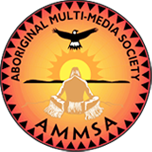Article Origin
Volume
Issue
Year
Page 8
Taking aim at an imaginary seal in a crowded school gym located in the prairies may be an unusual way of developing self-respect, but if the screeching laughter of dozens of children and the delight of hundreds of spectators is any indication, the seal dance did the trick.
It was one of many teaching tools used to build respect for self, earth and community, the theme of the fourth annual youth conference in Kehewin held on May 16 and 17.
More than 400 students from four provinces attended the interactive two-day affair with workshops conducted by 20 guest speakers.
One of the international guests was Tanya Lukin, an Alutiiq from Kodiak Island in Alaska. Presiding over the modern dance workshop, Lukin believes the purpose of dance, besides to entertain, allows children the chance to develop confidence and self-esteem.
"When you have arts rooted in culture and give them praise, you have recognized and validated their skills," said Lukin, who is taking Native studies at the University of Alberta. "That helps them to feel good about themselves."
That's important, she added, because before respecting others, the earth or their Aboriginal heritage, Lukin said Aboriginal children have to believe in themselves.
"Dealing with dance and movement isn't normal because kids get shy. This gets them to loosen up and be free and talk about other things," said Lukin.
|
At another circle in the gym, those in the Maori culture discussion group combined movement with sound.
Originally from New Zealand, Aroha Crowchild has resided at Tsuu T'ina near Calgary for the past 22 years. With her family's assistance, she instructed those in her group about the Native traditions of the southern hemisphere.
"People are receptive to our dance because it's fun and lively and that's contagious," Crowchild said.
The use of dance, language and games are all methods towards keeping the Aboriginal history alive, she said.
"In the end, we have to compete against video games, television and loud music, so what and how we can get across the message in order to learn about ourselves (is needed)," said Crowchild.
These workshops, called the Community Action Plan, made their return after a one-year hiatus. Conference director Rosa John initiated this activity during Kehewin's second conference, but without receiving feedback dropped the idea last year.
However in 2001, when there weren't these shared groups, there was a disappointment expressed, she said, prompting her to gladly revitalize this portion of the conference for this year. Especially when she had heard of other reserves creating their own dance and singing troupes after the get-together in 2000.
Besides dance, other workshop themes included creative writing, medicine and environmental awareness, lead by Tom Wamiss of Port Hardy located at the northern tip of Vancouver Island, B.C.
His people, the Kwakwakawakw, are surrounded by the sea. The contrast seen on the prairies was stark, so he concentrated his theme on water conservation.
The message wasn't lost on one of his participants, 12-year-old Robbie Pruden of Gibbons. Pruden said everyone can take simple steps towards saving water.
"One idea to save water is instead of waiting for the water to be cold from the tap, fill up the pitcher (from the time the water is turned on) and then put it in the fridge," said Pruden. He was eventually chosen to be the spokesperson to share with the conference what was learned in the group.
The ceremonies closed with a performance by a four-person Aztec group from Mexico City. Eduardo Jaramillo danced around a flaming earthen pot, even letting the fire touch his skin. He said respecting fire comes with an appreciation of its dangers.
- 1332 views
